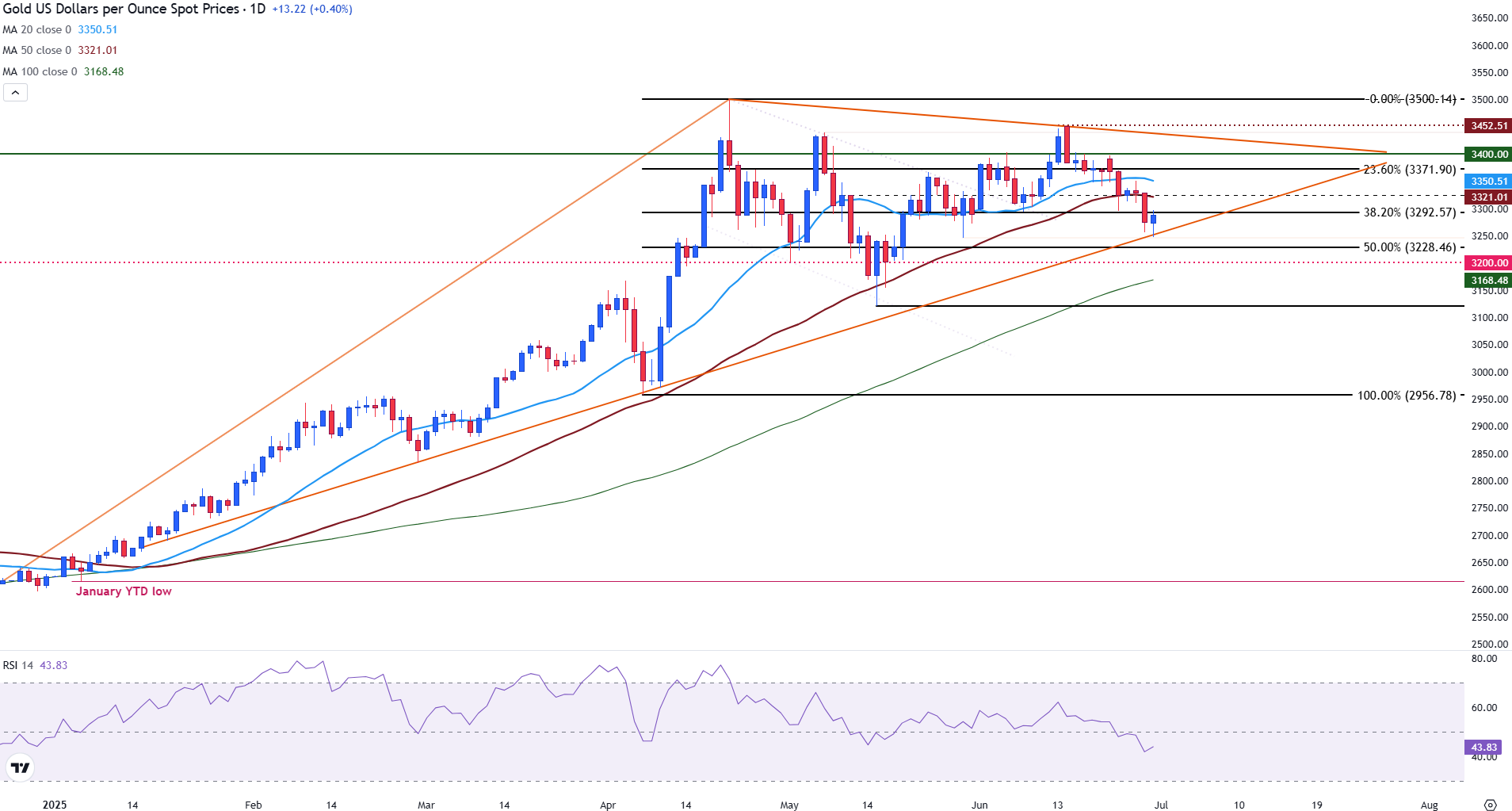Created
: 2025.06.30














![]() 2025.06.30 21:38
2025.06.30 21:38
Gold (XAU/USD) is entering the week below $3,300 at the time of writing on Monday as markets brace for heightened volatility ahead of Friday's US Independence Day holiday.
Political developments in the United States have taken center stage, with the US President Donald Trump's administration accelerating efforts to pass the "One Big Beautiful Bill" by his self-imposed July 4 deadline.
The legislation, which narrowly passed the Senate over the weekend, proposes a sweeping overhaul of the tax code, including broad deductions funded by cuts to Medicaid and green energy programs.
As debate intensifies, concerns over rising fiscal deficits and long-term inflation are beginning to weigh on the US Dollar, providing a supportive backdrop for Gold.
The Nonfarm Payrolls (NFP) report for June is scheduled for Thursday this time, earlier than usual due to the Fourth of July Independence Day holiday in the US on Friday.
Traders are positioning cautiously, anticipating potential shifts in currency and yield dynamics that could drive further demand for the precious metal.
Gold is trading at $3,280 at the time of writing on Monday, confined between the 50% and the 38.2% Fibonacci retracement levels of the April low-high move at $3,228 and $3,292, respectively.
This follows a recent break below both the 20-day and 50-day Simple Moving Averages (SMAs), which are providing additional resistance above the $3,300 psychological level at $3,350 and $3,320, respectively.
The metal's recovery attempts remain capped by resistance around the 38.2% Fibonacci retracement level at $3,292, while downside risks persist as momentum weakens.
Gold (XAU/USD) daily chart

The Relative Strength Index (RSI) indicator on the daily chart is currently pointing downward, near 44, indicating increasing bearish momentum without yet entering oversold territory. A daily close below $3,228 could open the door toward the 100-day SMA at $3,168, while a sustained push back above $3,292 would be needed to shift short-term sentiment back to the upside.
Gold has played a key role in human's history as it has been widely used as a store of value and medium of exchange. Currently, apart from its shine and usage for jewelry, the precious metal is widely seen as a safe-haven asset, meaning that it is considered a good investment during turbulent times. Gold is also widely seen as a hedge against inflation and against depreciating currencies as it doesn't rely on any specific issuer or government.
Central banks are the biggest Gold holders. In their aim to support their currencies in turbulent times, central banks tend to diversify their reserves and buy Gold to improve the perceived strength of the economy and the currency. High Gold reserves can be a source of trust for a country's solvency. Central banks added 1,136 tonnes of Gold worth around $70 billion to their reserves in 2022, according to data from the World Gold Council. This is the highest yearly purchase since records began. Central banks from emerging economies such as China, India and Turkey are quickly increasing their Gold reserves.
Gold has an inverse correlation with the US Dollar and US Treasuries, which are both major reserve and safe-haven assets. When the Dollar depreciates, Gold tends to rise, enabling investors and central banks to diversify their assets in turbulent times. Gold is also inversely correlated with risk assets. A rally in the stock market tends to weaken Gold price, while sell-offs in riskier markets tend to favor the precious metal.
The price can move due to a wide range of factors. Geopolitical instability or fears of a deep recession can quickly make Gold price escalate due to its safe-haven status. As a yield-less asset, Gold tends to rise with lower interest rates, while higher cost of money usually weighs down on the yellow metal. Still, most moves depend on how the US Dollar (USD) behaves as the asset is priced in dollars (XAU/USD). A strong Dollar tends to keep the price of Gold controlled, whereas a weaker Dollar is likely to push Gold prices up.
![]()
Created
: 2025.06.30
![]()
Last updated
: 2025.06.30

FXStreet is a forex information website, delivering market analysis and news articles 24/7.
It features a number of articles contributed by well-known analysts, in addition to the ones by its editorial team.
Founded in 2000 by Francesc Riverola, a Spanish economist, it has grown to become a world-renowned information website.
We hope you find this article useful. Any comments or suggestions will be greatly appreciated.
We are also looking for writers with extensive experience in forex and crypto to join us.
please contact us at [email protected].
Disclaimer:
All information and content provided on this website is provided for informational purposes only and is not intended to solicit any investment. Although all efforts are made in order to ensure that the information is correct, no guarantee is provided for the accuracy of any content on this website. Any decision made shall be the responsibility of the investor and Myforex does not take any responsibility whatsoever regarding the use of any information provided herein.
The content provided on this website belongs to Myforex and, where stated, the relevant licensors. All rights are reserved by Myforex and the relevant licensors, and no content of this website, whether in full or in part, shall be copied or displayed elsewhere without the explicit written permission of the relevant copyright holder. If you wish to use any part of the content provided on this website, please ensure that you contact Myforex.
Myforex uses cookies to improve the convenience and functionality of this website. This website may include cookies not only by us but also by third parties (advertisers, log analysts, etc.) for the purpose of tracking the activities of users. Cookie policy